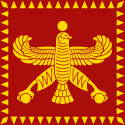Eber-Nari
| Eber-Nari 𒆳𒂊𒄵𒀀𒇉 ( Satrapy of the Achaemenid Empire | |||||||||
|---|---|---|---|---|---|---|---|---|---|
| c. 539 BC–c. 332 BC | |||||||||
|
Standard of Cyrus the Great | |||||||||
| Historical era | Axial Age | ||||||||
| c. 539 BC | |||||||||
| c. 332 BC | |||||||||
| |||||||||
Eber-Nari or Ebir-Nari (Akkadian), also Abar-Nahara (Aramaic) or Aber Nahra (Syriac), was a region of the ancient Near East. Translated as "Beyond the River" or "Across the River" in both the Akkadian and Aramaic languages, it referred to the land on the opposite side of the Euphrates from the perspective of Mesopotamia and Persia. In this context, the region is further known to modern scholars as Transeuphratia (French: Transeuphratène). Functioning as a satrapy, it was originally administered by the Neo-Assyrian Empire before being absorbed by the Neo-Babylonian Empire and then by the Achaemenid Empire. During the Greek conquest of Persia, Eber-Nari was, like the rest of the Achaemenid Empire, annexed by the Macedonian Empire of Alexander the Great. It was later dissolved by the Seleucid Empire, which incorporated it into Syria, along with Assyria.
In the "DSf" Achaemenid royal inscription, the Akkadian Eber-Nari is referred to as Athura or Athuriya in Old Persian and as Aššur in Elamite.[1][2] The Targum Onkelos, an Aramaic translation of the Torah, lists Nineveh, Calah, Reheboth, and Resen as being in the Athura jurisdiction.
Etymology
- Akkadian: 𒆳𒂊𒄵𒀀𒇉, romanized: Eber-Nāri [KUR.e.bir.ID₂], lit. 'trans river' — i.e. the region west of the Euphrates.[3][4]
- Hebrew: עבר הנהר, romanized: ʿĒḇer haNāhār, lit. 'the trans river' — i.e. beyond the river.[5][7][8][9]
The province is also mentioned extensively in the Biblical books of Ezra and Nehemiah as עבר הנהר ('Ever Hannahar' in modern pronunciation). Additionally, sharing the same root meaning, Eber (pronounced Evver) was also a character in the Hebrew Bible from which the term Hebrew was widely believed to have been derived (see: Eber), thus the Hebrews were inferred to have been the people who crossed into Canaan across the (Euphrates or the Jordan) river.
History

Assyria
The term was established during the
Babylonia, Egypt, and Persia
Subsequent to this Eber-Nari was fought over by the Neo-Babylonian Empire (612–539 BC) and Egypt, the latter of which had entered the region in a belated attempt to aid its former Assyrian overlords. The Babylonians and their allies eventually defeated the Egyptians (and remnants of the Assyrian army) and assumed control of the region, which they continued to call Eber-Nari.
The Babylonians were overthrown by the
In 535 BC the Persian king

The satrap of Eber-Nari resided in Babylon and there were subgovernors in Eber-Nari, one of which was Tattenai, mentioned in both the Bible and Babylonian cuneiform documents.[12] This organization remained untouched until at least 486 BC (Xerxes I's reign), but before c. 450 BC the "mega-satrapy" was split into two—Babylonia and Eber-Nari.[13]
Greece
Eber-Nari was dissolved during the
Notes
- ^ John, Boardman (1991). The Cambridge Ancient History: pt. 1. The prehistory of the Balkans; and the Middle East and the Aegean world, tenth to eighth centuries B.C. Cambridge University Press. pp. 433–434.
In the Babylonian version of the text the transportation to Babylon is credited to the people of eber nari, showing that to the scribe or scribes of these inscriptions the Babylonian equivalent of Old Persian Athura was eber nari...
- ^ Shawn Tuell, Steven. The Law of the Temple in Ezekiel 40-48. Scholars Press. p. 158.
Moreover, in a bilingual building inscription of Darius at Susa, the Old Persian kara hya Athuriya ("people of the Assyrians") is rendered in Akkadian as sabe sa eber nari ("people of eber nari")...
- ISBN 978-0-931464-86-7.
Eber nāri (geo) the region west of the Euphrates, Syria—NA, NB, LB.
- ^ "saao/saa01/qpn-x-places/Eber-nari[across the river]". oracc.museum.upenn.edu. Retrieved 2021-03-21.
- ^ ISBN 978-0-567-21617-5.
The region of Ebir-nari (Transeuphrates, called Avarnaharā' in Aramaic and Ēver-ha-Nāhār in Hebrew)
- ^ Thomas Kelly Cheyne; John Sutherland Black (1903). Encyclopædia biblica: a critical dictionary of the literary, political and religious history, the archæology, geography, and natural history of the Bible. A. and C. Black. p. 4857. Image of p. 4857 at Google Books
- ^ George V. Wigram (1890). The Englishman's Hebrew and Chaldee Concordance of the Old Testament: Being an Attempt at a Verbal Connection Between the Original and the English Translation: With Indexes, a List of the Proper Names, and Their Occurrences, Etc. Samuel Bagster and sons. pp. 798–799. Image of p. 798 at Google Books
- ^ Wilhelm Gesenius; Francis Brown; Samuel Rolles Driver (1906). A Hebrew and English Lexicon of the Old Testament: With an Appendix Containing the Biblical Aramaic. Houghton, Mifflin. p. 719. Image of p. 719 at Google Books
- ISBN 978-0-8028-2400-4.
- ^ Tuell 1991, p. 51.
- ^ Dandamaev 1994.
- ^ Olmstead 1944.
- ^ Stolper 1989; Dandamaev 1994.
- ^ Dandamaev 1994
- ^ Dumbrell 1971; Tuell 1991.
References
- Dandamaev, M (1994): "Eber-Nari", in Encyclopaedia Iranicavol. 7.
- Drumbrell, WJ (1971): "The Tell el-Maskuta Bowls and the 'Kingdom' of Qedar in the Persian Period", BASOR 203, pp. 33–44.
- Elayi, J; Sapin, J (1998): "Beyond the River: New Perspectives on Transeuphratene". A&C Black. ISBN 978-1-85075-678-1.
- Olmstead, AT (1944): "Tettenai, Governor of Across the River", JNES 3 n. 1, p. 46.
- Stolper, MW (1989): "The Governor of Babylon and Across-the-River in 486 B.C.", JNES 48 n. 4, pp. 283–305.
- Tuell (1991): "The Southern and Eastern Borders of Abar-Nahara", BASOR n. 284, pp. 51–57.
- Parpola, S (1970): "Neo-Assyrian Toponyms, Alter Orient und Altes Testament". Veröffentlichungen zur Kultur und Geschichte des Alten Orients und des Alten Testaments 6, Neukirchen-Vluyn, p116
- Zadok, R (1985): "Geographical Names According to New and Late-Babylonian Texts", Beihefte zum Tübinger Atlas des Vorderen Orients, Répertoire Géographique des Textes Cunéiformes 8, Wiesbaden, p129


